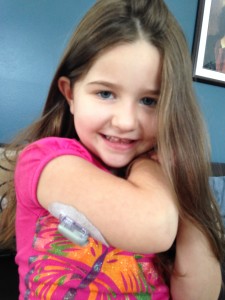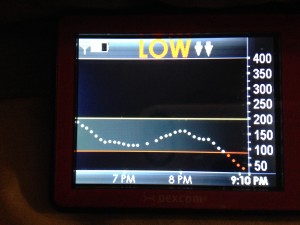Several years ago, we did a trial for a continuous glucose monitor (CGM). This device gives a measure of interstitial glucose every five minutes. When we tested the Medtronic version of this device a couple of years ago, we decided it wasn’t worth the time and money. The receiver had to be nearly touching the sensor on Lyla or it would say it was out of range, the alarm on it wasn’t loud enough for us to hear, it was off by a hundred points or more, the sensor had to be changed every couple of days, and it left a huge red sore on Lyla.
Since that time, I have heard the parents of diabetics talk about the new Dexcom CGM and how much they like it. Many of my initial complaints about the Medtronic version were fixed in the new Dexcom. The sensor and monitor can be up to 20 feet from each other, the alarm is loud, it is fairly accurate, only has to be changed once a week and doesn’t leave a mark at all. As I heard the parents talk, I really wanted to try it. With blood sugar checks, we are only able to see one single point in time, but have no real idea what direction blood sugar is going. For instance, one day I checked Lyla’s blood before preschool and she was at 104. If she was 104 and dropping, she needed sugar; 104 and stable is great; 104 and rising is fine as long as she doesn’t rise too much. Without a CGM, I have no idea of the directional trend of her blood sugar, so we always err on the side of caution, which isn’t always great for her. When she was at 104 before preschool, I gave her a little candy to ensure she didn’t fall too low at school. When she had snack that day, her blood sugar was 256. Obviously, she was 104 and climbing, but I had no idea.
Once I heard several positive stories about the Dexcom, I started working with our medical supplier and insurance company to get it. We immediately got denied. The Dexcom was only FDA approved for 18 and older because they had only done testing on it for that population. We started a long appeal process with the insurance and provided all sorts of documentation justifying why we needed this device.
The CGM is especially helpful for hypoglycemic unawareness, which is when the diabetic is dangerously low and doesn’t recognize it. It can become critical, even fatal if it goes unrecognized too long. Our concern for Lyla is that she is unaware in social situations. She is so excited to be with friends and around people that she doesn’t recognize that her blood sugar is dropping. The CGM will alarm us and allow us to better catch those lows. I wrote letters to the insurance company and documented every unexpected high and low to try to get the insurance to approve it. We were in the appeal process for months when we got exciting news that the FDA had just approved the device for those two and older. We were thrilled. I called our medical supplier and insurance the next morning and it was approved within days. It actually arrived just a week before I was due with the new baby. I knew it would be a great tool for those watching Lyla while I was in the hospital, so I watched all the training videos online so we could be ready to put it on her when it came.
Greg was initially hesitant, but we both agree that we LOVE it now. We can’t imagine life without it. It does drive me crazy at times, beeping when she is high or low, but it also allows us to sleep through the night (when all three kids allow it) without setting our alarms to check her. The CGM (“Dexie”, as Lyla calls it) will wake us if she is too high or too low. We are still waiting for the magical night when both Greg and I sleep uninterrupted through the night. It hasn’t come yet, but with Dexie, there is hope that it might.
We have put the sensor for the Dexcom on the back of Lyla’s arm. We know several kids who have them on their bums or stomach, but Lyla doesn’t have enough fat on her stomach and her bum has her insulin pump site. We have been surprised at how well her arm has worked and how little it has bothered her. She has had lots of people ask about it and with only one exception, she has simply answered that it is her sensor without being phased.
Here is a picture of the receiver. I usually keep it with me. It will pick her up almost anywhere in the house, and I can look at it any time I want to know how she is doing.
The receiver shows a trend line of where her blood sugar has been for the last 2-24 hours (depending on how you have it set), and gives her current reading along with how fast her blood sugar is changing. If she is slowly climbing, it shows the arrow like above. If she is climbing faster, the arrow is straight up and if she is really jumping up fast, she has a double arrow up. The arrows work exactly the same if she is falling. The receiver also alarms if she is falling fast or rising fast.
We still have to check her blood to make sure it is accurate before we give insulin or sugar, but we do far fewer blood checks than we used to. It also has a little bit of a delay, so it will show that she’s still dropping after we have given her sugar to bring her up. Even with the delay, though, it is great for keeping her in a healthier range.
We’ve already had a few times when I’m pretty sure Dexie has saved us from serious emergencies or worse. One night, I checked Dexie as we were putting the kids to bed around 8 p.m. It showed she was 150 and stable. It had been a fairly normal evening, and she hadn’t eaten or had any insulin since dinner a few hours before. Prior to having Dexie, we would do a bedtime blood check, then check again between 10 p.m.-midnight when we went to bed. On this particular night, we got the kids to bed and then Greg and I laid on the bed and were watching TV. Not an hour later, Dexie started beeping that she was low, then immediately started beeping that she was falling fast (double arrow down). We checked her blood, and sure enough, she was low. We gave her juice and a few minutes later, Dexie showed this:
It was pretty terrifying. Basically, it means her blood sugar was lower than 40 (that is as low as Dexie registers, then it just says LOW) and dropping fast (two arrows down). We gave her more juice, and more juice and finally stabilized her. I’m not sure how low she got, but she managed to sleep through the episode. She had three juice boxes and still only got up to 110, where she stayed throughout the night. I have no idea what would have happened if we didn’t have Dexie to tell us that she was dropping. You can seen from the picture, when we checked her at bedtime (8 p.m.), she was doing great and had been pretty stable. There would have been no reason to check her again for several hours. It is terrifying to think about. I still have no idea what brought the low blood sugar on, or how we could have prevented it. Diabetes is just like that sometimes. Scary!
My favorite thing about Dexie has been the ability to fine-tune Lyla’s diabetes management to have healthier numbers. I can see if she is climbing and can give her more insulin before she reaches too high. I have been able to watch trends to see how her body responds to different foods and at different times of day. For example, it takes the insulin about 15-30 minutes in the morning to hit and start working. I usually have her wait to eat breakfast until I see her numbers start to drop, or she will rise too quickly and get too high. At lunch, the wait time is about 5-10 minutes, and at dinner the insulin hits almost immediately. We’ve also been able to be more aggressive in our management because we aren’t worried about her having lows without us knowing. The technology isn’t perfect and Dexie can have days where it isn’t accurate, but overall we love it. I think it will do great things for her long-term health. Our last visit to the endocrinologist confirmed it — her A1C, which measures blood glucose over a three month period was great!


